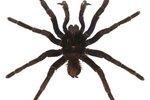Although the pretty yellow California dogface butterfly (Zerene eurydice) is the state insect of California, most Californians have never seen one -- mainly because this butterfly population is sparse and has a restricted range. You’re unlikely to see other stages of the life cycle, either -- the eggs are tiny and the caterpillars only feed on one species of plant.
Adult Form
Both sets of the female wings are yellow with a black dot on each of the fore wings. The males have more black on their fore wings, enclosing what looks, if you squint hard, a little like a creamy poodle face, giving the species its common name. The adults are on the wing twice a year, once in the spring and early summer and again in the fall, feeding on available wildflowers, especially thistles, anything purple and members of the mustard family. The males actively seek out females, although not a great deal is known about their breeding behavior.
Eggs
After courtship and mating, the female lays eggs on host shrubs. Although she can lay up to 100 eggs, she deposits them one at a time over a large area, which reduces the chances that a predator or accident could wipe out the lot. The eggs are a pale green when freshly laid, darkening to a deep red over time.
Larvae
The caterpillars have green bodies with a pale stripe along the length, which renders them inconspicuous against the vegetation. They have a narrow diet, feeding only on the leaves of the false indigo (Amorpha californica), a shrub found near rivers and streams.
Pupae
This species pupates among the vegetation they grew in, with the caterpillar using silk threads to attach itself to stems. Like the larvae, the pupae are a clear green as camouflage. The adult butterflies emerge about two weeks later.
Predators
The California dogface is vulnerable to predation at all stages of its life cycle, providing lunch for creatures ranging from spiders to reptiles. At the larval and pupal stages, the insect relies on camouflage rather than toxins or irritating hairs to escape predators, and this does not always work. Among the animals known to eat the larvae, pupae and adults are ants, lizards, snakes, parasitic wasps and toads. The eggs are probably vulnerable to smaller predators.
References
Writer Bio
Judith Willson has been writing since 2009, specializing in environmental and scientific topics. She has written content for school websites and worked for a Glasgow newspaper. Willson has a Master of Arts in English from the University of Aberdeen, Scotland.





